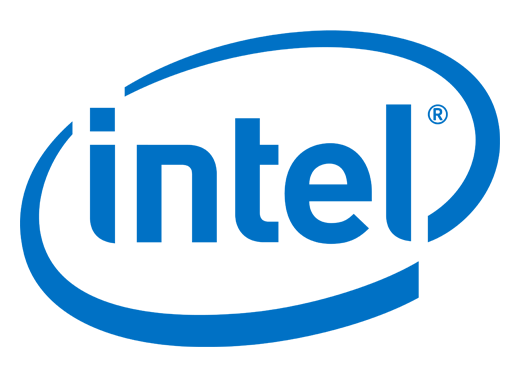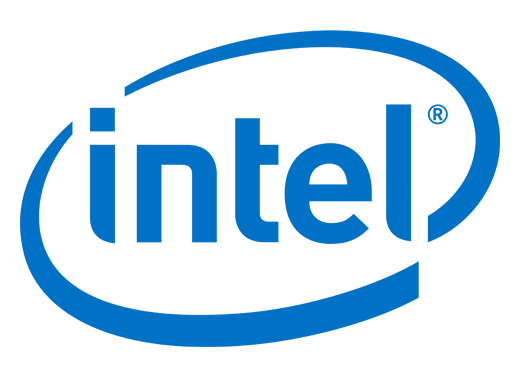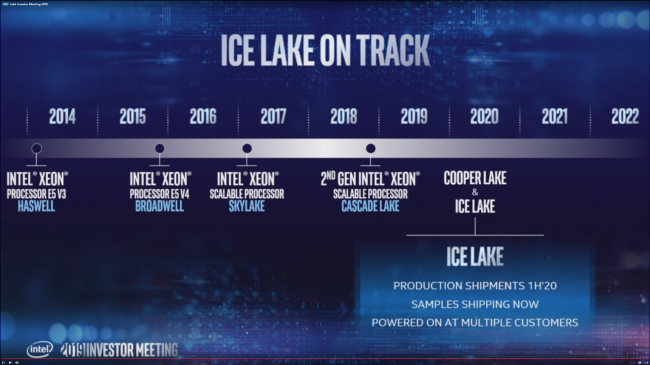Intel refutes recent reports from industry analysts that claim the company will further delay its server roadmap.
Intel Refutes Reports of Further Roadmap Delays : Read more
Intel Refutes Reports of Further Roadmap Delays : Read more
"Given the error of margin with Intel's roadmap projections, it's possible we won’t know if Ice Lake is actually on track until December 31, 2020. "
Actually, any announcement after Black Friday 2020 (2020-11-27) shouldn't count towards a 2020 release. Particularly, if there are continuous supply constraint issues, SKU's are not available for DIY builds or they are vastly overpriced SKU's (which is what happened when Skylake was released (announced in August 2015) later in 2015 with prices $100+ above MSRP).
So anything announced after say September 2020 counts towards calendar Q1 2021, if there are any significant supply or pricing issues during the 2020 holiday buying season.
Do you want 10th generation 14nm desktop silicon in the March 2020 time frame or do you want 11th generation 10nm desktop silicon in the September 2020 time frame? Because I have absolutely no faith in Intel's own purported roadmaps, in light of their own repeated delays at 10mn.
Yes.All the platforms mentioned in the article are enterprise Xeon platforms.
Of course, the Xeon branded processors are also sold for workstations. I built a Xeon-based workstation, though I used a tray-only CPU model, and was lucky to find someone to sell me one. For example: http://www.nextwarehouse.com/item/?...MI-J7xidmx5gIVS18NCh13TwtbEAkYAyABEgKqtfD_BwEThere is no Xeon DIY market and pretty much all Xeons are bought in prebuilt servers.
BTW, there are some funny reviews on this one. Some more funny than others, but still cute.Finally, you can also buy server boards and retail-boxed server processors. Example: https://www.newegg.com/p/N82E16819117904
AMD doesn't seem interested in FPGAs or neural network processors just yet, and considering the company is an order of magnitude smaller than Intel, that's probably for the best. They just don't have the resources to compete with Intel in every single market.Intel released 10nm Ice Lake laptop chips first. Those are in 30 laptop designs.
Their 10nm 3D hybrid Lakefield chips are announced in two designs.
Their 10nm NNP-I chips are shipping.
Their 10nm Agilex FPGA chips are shipping.
on the AMD competition ... no 7nm apu, no 3D manufacturing design, no NNP chips, no FPGAs.
It isn't necessarilyt so much that 10nm is struggling with clocks than it may be about Intel adding too much extra logic to the core: Skylake's re-order buffer is 224 entries deep while Sunny Cove is 352 entries deep, that's in excess of 50% more logic there and unless the process is in excess of 50% faster, that would translate to lower clocks assuming there are some critical paths in there... and it should be a pretty safe bet that Skylake's 224 depth was picked to align the scheduler's critical paths with other function blocks' critical paths.It's clear by now that 10nm is ready for mass production for many use cases, but desktop CPUs rely on high clock speeds, which is where 10nm has struggled so far.
You definitely have a point there, but we can only see what the true impact is until Rocket Lake comes out. I certainly don't expect it to reach 5GHz as easily as Coffee Lake, but what will the difference be?It isn't necessarilyt so much that 10nm is struggling with clocks than it may be about Intel adding too much extra logic to the core: Skylake's re-order buffer is 224 entries deep while Sunny Cove is 352 entries deep, that's in excess of 50% more logic there and unless the process is in excess of 50% faster, that would translate to lower clocks assuming there are some critical paths in there... and it should be a pretty safe bet that Skylake's 224 depth was picked to align the scheduler's critical paths with other function blocks' critical paths.
AMD doesn't seem interested in FPGAs or neural network processors just yet, and considering the company is an order of magnitude smaller than Intel, that's probably for the best. They just don't have the resources to compete with Intel in every single market.
Lakefield is currently in a bit of a 'wait-and-see' state for me but it looks promising in many aspects. Be aware that 3D stacking, while it increases density tremendously, also concentrates more heat in a small area because the actual manufacturing process is still the same. That's why we won't see it in high-performance products in the near future, although it's definitely on the way.
It's clear by now that 10nm is ready for mass production for many use cases, but desktop CPUs rely on high clock speeds, which is where 10nm has struggled so far. As we've seen in mobile, it currently loses 500-700MHz compared to 14nm, which nullifies a significant part of the IPC gains from Sunny Cove.
AMD looks a little tight-lipped on Renoir, but if 3rd gen Threadripper's launch is anything to go by, that means very little. It's very likely that 7nm APUs for mobile will launch shortly after CES, like last year.
Between me being in the general ballpark of how much extra logic may have been added along some critical paths, the performance penalties from back-porting Sunny to 14nm and Intel's further refinement of 14nm, I'd expect the OC ceiling under conventional cooling to be around 4.5GHz.You definitely have a point there, but we can only see what the true impact is until Rocket Lake comes out. I certainly don't expect it to reach 5GHz as easily as Coffee Lake, but what will the difference be?
You've been talking like clocks are directly interchangeable with critical path - as if a chip with half the critical path but double the clocks would burn the same power. I'm skeptical.It isn't necessarilyt so much that 10nm is struggling with clocks than it may be about Intel adding too much extra logic to the core:
Lol. Who's afraid, other than Intel? Who's panicking, other than you?Speculation like this just creates fear and causes people to panic for no good reason. I
Clocks and critical path are directly related - if your critical path is half as long, you could hypothetically get close to double the clock. Never said anything about efficiency though. Making the transistors switch twice as fast will require more current to charge/discharge the gates faster and delivering that current will require higher voltage, which means efficiency goes to hell at some point. Also, doing less work per clock typically means more pipeline stages to spread the work between and tends to make efficiency to go to hell even faster.You've been talking like clocks are directly interchangeable with critical path - as if a chip with half the critical path but double the clocks would burn the same power. I'm skeptical.
Yes, that much is plain to see.Clocks and critical path are directly related - if your critical path is half as long, you could hypothetically get close to double the clock.
Okay, that's in line with what I thought. Thanks for clarifying.Never said anything about efficiency though. Making the transistors switch twice as fast will require more current to charge/discharge the gates faster and delivering that current will require higher voltage, which means efficiency goes to hell at some point.
Yes, longer pipelines tend to have a higher branch misprediction penalty. I also wonder if there's not some overhead associated with each pipeline stage, but I don't know if that's significant.Also, doing less work per clock typically means more pipeline stages to spread the work between and tends to make efficiency to go to hell even faster.
The biggest overhead is simply that as you raise frequency, setup, hold and any other timing slack your design requires to ensure predictable behavior (avoid data-to-clock race conditions) ends up accounting for a much larger portion of your total cycle time, which means that much less time to get actual useful work done.I also wonder if there's not some overhead associated with each pipeline stage, but I don't know if that's significant.
Lol. Who's afraid, other than Intel? Who's panicking, other than you?

 semiaccurate.com
semiaccurate.com

 www.semiaccurate.com
www.semiaccurate.com
Three years later than it was supposed to, at 10-15% lower clocks than people expected with one scrapped architecture (Cannon Lake) under its belt that never made it past dual-core IGP-less embedded silicon. While 10nm may not be dead, there is no contesting that it has been woefully problematic so far.For a dead process and PR stunt its odd that you can buy a 10nm powered laptop today.
Three years later than it was supposed to, at 10-15% lower clocks than people expected with one scrapped architecture (Cannon Lake) under its belt that never made it past dual-core IGP-less embedded silicon. While 10nm may not be dead, there is no contesting that it has been woefully problematic so far.
Since Intel makes FPGAs and large FPGA customers are things like telecom, military equipment, instrumentation, science, etc. often attached to long-term supply agreements, Intel can't really back down from 10nm. What it can do though is refrain from launching more products on it, which is pretty much what the leaked roadmaps seem to confirm: most CPU products are sticking to 14nm through 2021. If 10nm was actually doing well, Intel would be doing the same thing it has always done when it had its next process up to speed: move the highest margin products to the new process ASAP, upgrade old fabs, move more products to the new process as upgraded lines come online, rinse and repeat until everything worth manufacturing on the new process has been migrated.
Intel has always had a pretty aggressive migration strategy in the past. No sign of it yet for 10nm and we even have rumors of 10nm designs getting back-ported to 14nm instead. Seems like 10nm is still nowhere near where Intel wants it to be.
Well, 10nm not being anywhere near it should be by now is not a rumor, almost everyone else is already at least on par with Intel's best-case for 10nm on Samsung and TSMC's 7nm.Rumors are rumors though. You should know just as well as I do that rumors can be even more so depending on the source.
Well, 10nm not being anywhere near it should be by now is not a rumor, almost everyone else is already at least on par with Intel's best-case for 10nm on Samsung and TSMC's 7nm.
The article that you cited. Nobody was talking about that (and still nobody but you), until you injected it into the discussion. It feels to me like you're just trying to change the subject to one you can more easily "win". I don't see how that's constructive.But the article is a rumor and speculation posted by someone who stated before...
It's clear by now that 10nm is ready for mass production for many use cases,
Speculation like this just creates fear and causes people to panic for no good reason. I
The article that you cited. Nobody was talking about that (and still nobody but you), until you injected it into the discussion. It feels to me like you're just trying to change the subject to one you can more easily "win". I don't see how that's constructive.
The most bizarre part is that @MasterMadBones wasn't too far off what you're saying.
So, I don't really get why you went off on this track:
It feels to me like you're panicking about something, for some reason. Do you have any vested interests in the matter? Like, any shares of Intel stock or friends/relatives who work at Intel?
A report from SemiAccurate today claimed that Intel has significantly delayed its "entire server roadmap," and a follow-on report from Wells Fargo analyst Aaron Rakers, which cites the SemiAccurate report and "industry checks," seemingly reaffirms that Intel has hit yet another roadblock on its path to recovering from its incessant 10nm delays, thus impacting delivery of the Ice Lake processors for the data center.
The entire TH article is based off of speculation from SemiAccurate:
a follow-on report from Wells Fargo analyst Aaron Rakers, which cites the SemiAccurate report and "industry checks," seemingly reaffirms that Intel has hit yet another roadblock on its path to recovering from its incessant 10nm delays
We can't know that. Others are surely interested and are no doubt digging around.If that article did not exist this one wouldn't.
Thanks for clarifying that. I didn't say you were a fanboy, but you seem consistently defensive of Intel.I have no stock in Intel nor does any of my family or myself work for Intel. I did have one friend long ago who moved to Chandler to work for Intel but I never kept in touch with him.
...
Not sure I understand why that is important but I guess to you if I am not going along with rumors or speculation I ma a fanboy?
I don't even visit the site, any more, because everything except reviews is behind their paywall. Even old articles are pay-walled. From what I recall, he had a fairly blatant anti-Intel, anti-Nvidia bias. But not so bad that he would go so far as to say something was bad, if it wasn't. Just that he would tend to focus on the negatives and gloom.FYI, I don't go along with ANYTHING Charlie says. He has been known to do this, especially when a company is having some problems or delays its all doom and gloom.
It's funny that you mention Broadwell, because I think we're seeing it play out in exactly the same way: mobile + server. Just like Broadwell.The fact is that Intel is shipping 10nm, not in the volume they would want but it is shipping and not delayed nor is it the paper tiger that Broadwell was.
Oh, but they did slip! This clearly shows availability in Q2:Until we see otherwise the assumption should be that 10nm Xeons are on target for their launch. Anything outside thats not confirmed by an official source is rumor and speculation.


Except:
So, you have somebody else who's not just taking their word for it. Just because SA isn't always right doesn't mean they're necessarily wrong. We can only wait and see.
We can't know that. Others are surely interested and are no doubt digging around.
Thanks for clarifying that. I didn't say you were a fanboy, but you seem consistently defensive of Intel.
FWIW, I sort of know a few AMD employees, a current & former Nvidia employee, and several former Intel employees. None of the Intel folks have any current info on their CPUs or manufacturing process issues. The worst I've heard is just some gossip about their corporate culture, which wasn't terribly flattering. That was under the previous CEO, however.
I don't even visit the site, any more, because everything except reviews is behind their paywall. Even old articles are pay-walled. From what I recall, he had a fairly blatant anti-Intel, anti-Nvidia bias. But not so bad that he would go so far as to say something was bad, if it wasn't. Just that he would tend to focus on the negatives and gloom.
It's funny that you mention Broadwell, because I think we're seeing it play out in exactly the same way: mobile + server. Just like Broadwell.
Oh, but they did slip! This clearly shows availability in Q2:
https://www.tomshardware.com/news/i...-5.0-roadmap-leaked-granite-rapids,39403.html
And the article features a slide shown at an investor meeting that clearly says 1H.

...and now they've been saying 2H.



